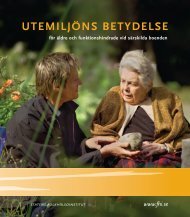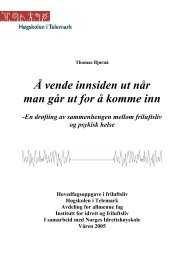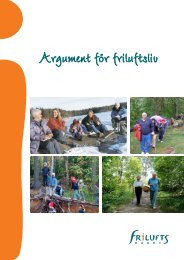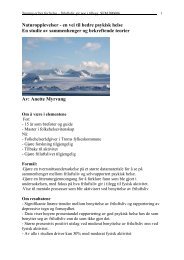Green Care: A Conceptual Framework - Frisk i naturen
Green Care: A Conceptual Framework - Frisk i naturen
Green Care: A Conceptual Framework - Frisk i naturen
You also want an ePaper? Increase the reach of your titles
YUMPU automatically turns print PDFs into web optimized ePapers that Google loves.
aware of it. This is very similar to using the transference in psychoanalytic<br />
psychotherapy. The process also works by the development of a safe and<br />
trusting relationship, in which emotional intersubjectivity and validation is<br />
experienced; for some people this may not be possible with other humans.<br />
The process itself, with or without analysis, can be experienced as healing<br />
and promoting of personal growth.<br />
In the overall field, two models are generally described: triangular and star<br />
shaped (see Fine, 2006). These are shown in Figure 3.5. The star shape<br />
involves four participants: patient, therapist, animal handler and the animal,<br />
whilst in the triangular model, there is the patient, the animal and the<br />
therapist (who is also the handler).<br />
Figure 3.5: Models of therapist involvement in animal assisted interventions<br />
PATIENT<br />
OR CLIENT<br />
ANIMAL<br />
(Adapted from Fine, 2006)<br />
THERAPIST<br />
PARENT<br />
OR CLIENT<br />
ANIMAL<br />
THERAPIST<br />
ANIMAL<br />
HANDLER<br />
In horticultural therapy the therapist works with the client to achieve<br />
specific goals. These may be the development of particular motor functions,<br />
work skills or psychological well-being through the use of horticulture. The<br />
UK charity Thrive uses the following definition of horticultural therapy<br />
agreed by practitioners in 1999. This also highlights the key role of the<br />
therapist.<br />
“Horticultural therapy is the use of plants by a trained<br />
professional as a medium through which certain clinically<br />
defined goals may be met.”<br />
Horticultural therapy has a pre-defined clinical goal similar to that found<br />
in occupational therapy. This distinguishes it from therapeutic horticulture<br />
which is directed towards improving the well-being of the individual in<br />
a more generalised way (see Sempik et al, 2003, p. 3). The horticultural<br />
therapist enables the client to carry out tasks successfully and so has to<br />
33















